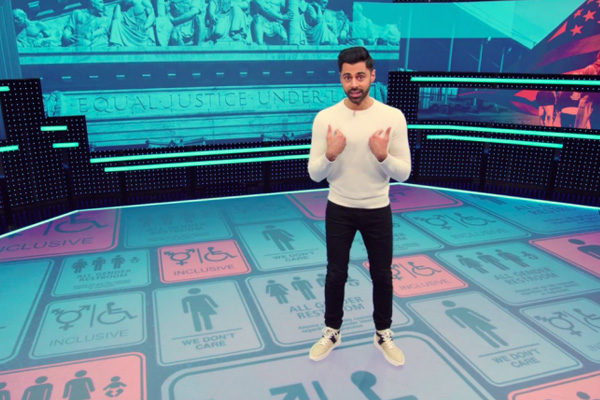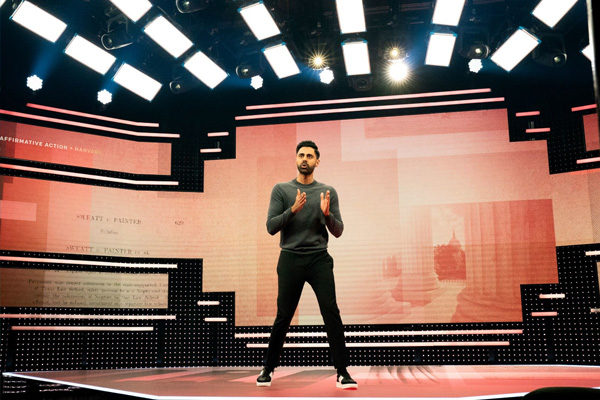Netflix and Hasan Minhaj Reinvent the Keynote

Few people were better at delivering a rousing, consistently on-message, and attention-getting keynote address than Apple’s Steve Jobs. Keynotes communicate a message to a large audience that is focused on one central issue. For Jobs, that often meant touting the latest and greatest Apple product to be launched.
His stage presence was a masterclass in whipping up anticipation and then delivering the big reveal in a manner that always seemed to result in a standing ovation and a stream of bloggers scrambling to be the first to share the hot news.
But even Jobs understood that soaring words and his near hypnotic delivery weren’t enough to win over every audience. He relied heavily on visual and auditory aids, often speaking in front of giant screens displaying his latest technological marvel.
Whether at a product launch, a college commencement, a TED talk, or an international conference, the classic keynote address hasn’t changed much in the last few years. A person on a stage speaks to a crowd, sometimes with the occasional chart or image to back up their current thought.
However, a newcomer to the scene is starting to shake things up with a keynote-style show that is leveraging design and technology in new and exciting ways.
Patriot Act’s Limitless Possibilities
Comedian Hasan Minhaj cut his teeth at Comedy Central’s “The Daily Show,” where the fine art of a mock newscaster with a funny graphic in a box over his shoulder has been refined to its highest form. Now headlining “Patriot Act,” his own show for Netflix, he is the centerpiece of a radical update to the classic format.
Minhaj opted for a more immersive and energetic take, one that looks more like the best keynote address you ever saw than a glorified Powerpoint presentation. “I made it very clear that I don’t want to be sitting behind a desk in front of a city skyline,” he told Time.
The stage design is nothing short of a technological marvel, one that Steve Jobs would no doubt have enjoyed the opportunity to use. Minhaj stands in front of a high-resolution 1.9mm LED video wall on an LED floor covered with diffusers.
“The floor also being LED and being able to host graphics, we thought it would be really cool to make it like an all-immersive environment, like he’s almost in the television or in the world that he’s talking about,” said the show’s executive producer Michelle Caputo.
In addition to the LED wall and floor, Spectron lights, normally used for rock concerts, can flood the entire set in color to accentuate big moments. According to Caputo, “These lights are really malleable. They can take on video, they have full dimming capacity, they can do a full spectrum of color. Nobody uses those types of things in television.”


The advantage of flooring, walls, and projectors that all accept video input is that the show’s look can be customized to match the content of each episode, which was important to Minhaj, who said: “I don’t want it to feel like, you know, just a red, white and blue political palate.” Executive producer Shannon Hartman told IndeWire, “He wanted to open it up and make something a little bit more artistic and fun.”
The show’s production designer, Marc Janowitz, explained that the video setup is integral to achieving Minhaj’s aesthetic vision for a varied and creative look: “The less specific we make the location, the more flexible and the more open we are creatively to how we can use screen content to really place us in every single week’s episode and as a result of that, it offers limitless possibilities.”
So what is the show presenting on all that screen real estate? Everything and anything one might need to transmit knowledge to others, including screenshots, infographics, images, video clips, charts, taglines, and comedy bits. When Minhaj makes a big point or drops the punchline, the whole stage pulses with dazzling patterns of light and color to accentuate his delivery. The creators call this a “firework” moment, a key juncture in the show that is both literally and figuratively illuminating.
Because his show tackles issues in politics and economics, generally dry and not easily understood topics, “Patriot Act” makes a concerted effort to package stale statistics and complex arguments indigestible and humorous segments — and they use their advanced stage design to make it all feel more like an enveloping theme park ride than a slideshow.
Immersive Video Takes Center Stage
Massive, high-resolution video walls of the kind Minhaj employs used to be exclusive to mega-venues like football stadiums. Today, costs are dropping and the technology is slowly but surely proliferating into more varied environments — and being used for more creative purposes than just showing the instant replay.
These new applications help explain why the international digital signage market is pegged to rise from just under $15b in 2015 to nearly $22b in 2020 according to Research and Markets.
“The display industry is advancing because customers are realizing a digital video wall is a more efficient way to communicate with large audiences,” argued Gary Feather, Chief Technology Officer at NanoLumens, a manufacturer of video walls.
L’Atelier des Lumières, a digital art center in Paris, is currently exhibiting a completely sold-out show called Van Gogh, la nuit étoilée, that transports visitors into the paintings of the French impressionist master thanks to video projection that covers every wall and the entire floor.
On the music scene, electronic dance music superstar Deadmau5 recently unveiled the third edition of the massive video cube he performs in. Cubev3 is a 21-foot-tall, 22-foot-wide, moving box of light and sound that made its debut at this year’s Ultra Music Festival in Miami.
Like his music, the cube is a work of programmable art. Deadmau5 (real name Joel Zimmerman), made the case that while others are just hitting the play button on their light show, his show is genuinely responsive to the music.
“Everyone in the world — I don’t care who you are — they’re playing video clips. They’re not using real-time GPU-generative content… Now, if I want to change something, I don’t have to go open up an Adobe Premiere or After Effects file and re-render the video. It’s just changing a few lines of code.”
In corporate offices, a slightly less bombastic environment than an EDM show, video walls are wowing guests and making lasting first impressions in the lobbies of the headquarters of tech giants like Salesforce and Comcast. The 106-foot-long LED screen at Salesforce’s tower in San Francisco is loaded with a number of jaw-dropping visuals, including a realistic fluid dynamic simulation of cascading water.
Salesforce program manager Chase Mattison told Display Daily: “We use the video wall for branding, supplying information, and providing a changing ambiance in the modern lobby space. Visitors to Salesforce are constantly commenting on how amazing our LED display looks.”
Create An Experience With Your Next Keynote
Hasan Minhaj is surely just the first to truly tap into the opportunities that immersive video and stage production presents for communicating to large audiences. The field is wide open and the technology is more accessible than ever.
Reading the bullet points off a grainy projector was never all that engaging, but now it feels downright archaic in comparison to floor-to-ceiling visual splendor and expertly choreographed “firework moments.”
We are a unique collective of ambitious makers, doers, and dreamers that work as one to push forward the power of what’s possible.
FG|PG was founded nearly 21 years ago. Today we’re one of the largest woman-owned, WBENC Certified, live, hybrid and virtual experiential agencies in the US. That trajectory isn’t accidental. It’s the result of a commitment to continually evolve, to never stop learning, and to always listen to our clients’ needs.